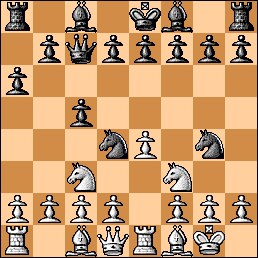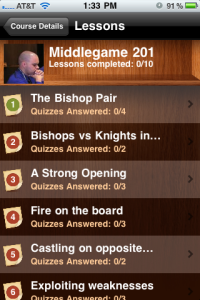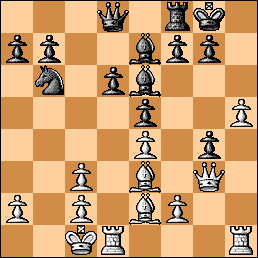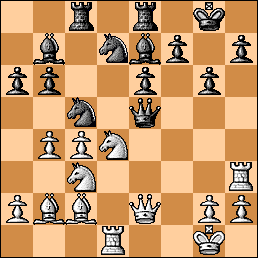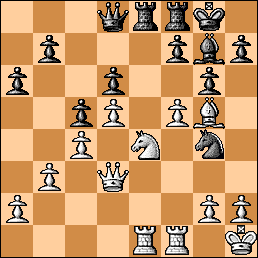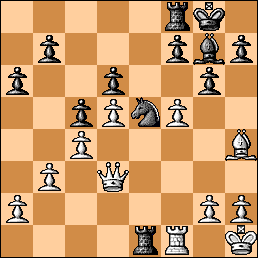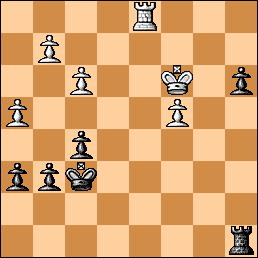The One and Only: Shirazi!
Iranian International Master Kamran Shirazi was a fixture on the NY Chess Scene in the 1980s and a dashing, enigmatic, figure. From Wikipedia, “He was known for playing strange and unorthodox openings. As this was a period of rating inflation, Shirazi’s rating rose rapidly and he became one of the highest rated players in the United States Chess Federation. However, when invited to play in the 1984 U.S. Chess Championship, Shirazi managed only one draw from 17 games, finishing last.[3] In that championship, Shirazi also achieved the dubious distinction of losing the shortest decisive game in the history of the U.S. Championship: his game as White against John Peters, which went 1.e4 c5 2.b4 cxb4 3.a3 d5 4.exd5 Qxd5 5.axb4?? Qe5+ 0-1.”
The Bar Point Details
I can add some details probably unknown to Wikipedia: in the early 1980s, a number of us crazy chess players slept over at the Bar Point chess club (14th Street and 6th Avenue in New York City) quite a bit. It was owned at one point by card player Peter Malick and at another point by Bill Goichberg. It started life as a backgammon club owned by err… a backgammon player – readers, need help here. We loved the sandwiches made by sandwich ladies Diana Lanni and Judy Shipman. The night-time denizen roster was strong: me, Jon Tisdall, Michael Rohde, and future poker great Howie Lederer. One night Shirazi showed up into our large, common, sleeping room known as the “Cloud Room.” I think it was called this because of the decrepit oversized pillows issued billowing clouds of dust creating “clouds” when they were moved around on the foam sofas. Shirazi enters the Cloud Room and announces “I am divorcing.” Tisdall hugs one particular pillow and says “You’re not getting my pillow.” I would categorize this as typical chess player banter. Shirazi was impressive in 1980’s tournaments with the ladies’ pick-up line: “Just Hold Me.” This line works. Fortunately his rating inflation led to my own because I defeated him numerous times in the 1980’s and 1990s, amassing a large plus record. The trick was to stay alert and not fall for some crazy Shirazi tactic. Many players were unable to do this (even strong ones) and succumbed to his strange play. One of his trademarks that you will see in the games below are wild, seemingly amateurish (OK, often amateurish) pawn lunges and strange minor piece formations.
Shirazi vs. Zuckerman
A typical dialog overheard at the Manhattan Chess Club Championship: Shirazi: “I am an artiste… I move the chess pieces… trying to create art….” Bernard Zuckerman (representing science and rationality): “I have no idea what you are talking about.” Well, let’s put some 1980s Shirazi games before the viewing public and let them make up their own minds.
On to the Chess!
Game 1. Kamran takes on a “rock”, GM Anatoly Lein.
Shirazi – Lein, US Championship 1986 French Winawer 4. Ne2 variation
1.e4 e6 2.d4 d5 3.Nc3 Bb4 4.Ne2 dxe4 5.a3 Be7 6.Nxe4 Nd7 7.Bf4 Ngf6 8.Qd3 A rather common sideline of the set of Winawer uncommon sidelines. Black is not supposed to have problems, but look what happens to the veteran!
9…O-O 9.O-O-O b6 10.Nxf6+ Nxf6 11.Qg3? The game continuation is just good for black.
11…Ne4! 12.Qe3 Bb7 13.f3 Nf6 14.Be5 Qd7? A boo-boo in return. The simple 14…Nd5 15. Qd3 Bg5+! 16. Kb1 a5! is very good for black as is 16. f4 Bh6! 17. c4 f6! – in both cases black has a strong initiative and Shirazi did not like to defend.
15.Kb1 Rac8 16.Nc3 a6? Bizarre and slow. 16…Nd5 is completely fine for black.
17.Bd3 b5 18.g4 The lunge 18. Qg5! is objectively stronger here.
18…Nd5 19.Nxd5 Bxd5 20.g5 Bd6 This instructive sequence builds a defense: 20…a5! 21. Qf4 Bd6 22. Rhg1 g6! 23. Rg3 Bxe5 24. dxe5 b4 25. Qh4 bxa3 26. Rh3 h5! 27. gxh6 Qd8! and black is fine.
21.Rhg1 c5?! And now black is really asking for it. He had the simple 21…Bxe5 22. dxe5 Rfd8 23. Rg3 c5! 24. Rh3 g6 25. Qf2 Qe7 and black is solid.
22.Rg3 c4? Now the situation demands the utmost care. He needed to play 22…cxd4! and now the sacrifice fails: 23. Bxh7+? Kxh7 24. Rh3+ Kg8 25. Qd3 f5! 26. gxf6 Bxe5 27. Qh7+ Kf7 28. Qxg7+ Ke8 29. Qxf8+ Kxf8 30. Rh8+ Kf7 31. Rh7+ Kxf6 32. Rxd7 Rg8 and by the immutable laws of Sturm und Drang, black winds up winning the ending. If white plays the superior 23. Qxd4 Bxe5 24. Qxe5 Rfd8 25. Rh3 g6 26. f4 Qc5 28. Ree3, trying to mate via the Rxh7 trick (see Game 6 for this failed motif re-occurring), black has the cold shower move 28…Bg2! guarding h3, getting the queens off, and reaching an equal ending. By the text move, Black was hoping he was showing incredible sangfroid. But it’s tactical short-sightedness as White is tempted into a winning sacrificial adventure.

Position after 22…c4 – time to pull the trigger!
23.Bxh7+! The conditions are right!
23...Kxh7 24.Rh3+ Kg6 The plausible 24…Kg8 is crushed by the nice sequence 25. Qf4 Bxe5 26. Qh4! f6 27. g6 and mate.
25.Rg1 Rg8 26.Qf4 White is lining up for some very nasty mates, some of which involve a queen sacrifice.
26…Bxe5 27.dxe5 Qe7 28.Qg4 c3 29.Rh4! Completing the entombment of black’s king.

Position after 29. Rh4. Resignation is forced.
The problem is that 29…Rh8 30. Rh6+! mates. 1-0
Now he takes on “Joe Solid”, aka “Mr. Trading Queens” or “Mr. Endgame”, Maxim Dlugy, in the 1985 US Championship. Evidently, there was no hangover from the 1/2 out of 17 score in the prior year’s version (in Berkeley – alarm bells, anyone?). Note to future US Championship organizers: 17 games is too long an event. In this perplexing game, Maxim does succeed in getting the queens off but Kamran confounds with unusual piece placements and pawn lunges.
Game 2. Shirazi – Dlugy, US Championship 1985 Caro-Kann 1.e4 c6 2.d4 d5 3.Nc3 dxe4 4.Nxe4 Nd7 5.Bc4 Ngf6 6.Ng5 e6 7.Qe2 Nb6 8.Bd3 h6 9.N5f3 c5 10.dxc5 Bxc5 11.Ne5 Nbd7 12.Ngf3 Nxe5 13.Nxe5 O-O 14.Bd2 Qd5 15.f4 b5 16.Be3 Bxe3 17.Qxe3 Bb7 18.Rg1 Rfd8 19.g4 Qd4 20.Qxd4 Rxd4 21.g5 hxg5 22.fxg5 Nh5 23.O-O-O Rd5 24.Rge1 Nf4 25.Bf1 a6 26.c4 Rc8 27.b3 f6 28.gxf6 gxf6 29.Nd7 Rxd1+ 30.Rxd1 f5 31.Rd4 Ng6 32.Kb2 b4 33.c5 Rc7 34.Bc4 Kf7 35.Rd6 Nf4 36.c6 Bc8 37.Rd4 Ng6 38.Nb8+ a5 39.Bb5 e5 40.Rd1 e4 41.h4! White’s perplexing play all over the board nets material shortly.
41…f4 42.h5 Ne5 43.Nd7 Nxc6 44.Bxc6 e3 45.Bd5+ Kg7 46.Rg1+ Kh6 47.Nf6 Bf5 48.Ng8+ Kxh5 49.Bf3+ Kh4 50.Rg2 Bh3 51.Rg1 Rd7 52.Kc1 Bf5 53.Nh6 Be6 54.Rg6 Bd5 55.Nf5+ Kh3 56.Rh6 mate. 1-0
Here is Kamran laying some hurt on many-time US Champ Lev Alburt when Lev incautiously avoids a draw by perpetual.
Game 3. Lev Alburt – Kamran G Shirazi 1983 US Championship Benoni Defense 1.d4 c5 2.d5 Nf6 3.Nc3 g6 4.e4 d6 5.Nf3 Bg7 6.Be2 O-O 7.O-O Na6 8.Nd2 Nc7 9.a4 e6 10.Nc4 exd5 11.exd5 b6 12.Bf4 Ba6 13.b3? Correct is 13. Qd3 with an edge. On the other hand, the capture orgy variation with 13. Bxd6 Bxc4 14. Bxc7 Bxe2 15. Bxd8 Bxd1 16. Bxf6 Bxc2 17. Bxg7 Kxg7 is dead equal. The text is a simple tactical oversight and indicative of Lev’s poor form in this game (see his blunder on move 20).

Position after 12. b3? – Black misses a tactical resource.
13…Re8? An amusing reciprocal blunder. Black had the obvious 13…Nfxd5 with a huge edge. The point is that 14. Nxd5 Nxd5 15. Qxd5 (if 15. Bxd6 Nc3! wins) 15…Bxa1 16. Rxa1? Qf6! is a double attack that wins for black. Even the better 16. Nxd6 Bxe2 17. Rxa1 Qf6 18. Be5 Qe6 should win for black. After the text, it’s equal.
14.Bf3 Nh5 15.Bd2 Bxc4 16.bxc4 Qh4 17.Be2 Be5 18.g3 Nxg3 19.hxg3 Bxg3 Naturally it should be a perpetual check draw now when white grabs the bishop.

Position after 19…Bxg3: Time for a rare Alburt miscue.
20.Kg2?? An irrational misjudgment exposed in only 2 moves, but this happens to the best of us. For Lev Alburt, this sort of grotesque blunder was indeed very rare in the 80s – he had great tournament results in the U.S.
20…Qh2+ 21.Kf3 Bxf2! Oops! The flaw is exposed. 22. Rxf2 Qh3+ 23. Kf4 is suicide: 23…Re5 threatening …g5 mate; if then 24. Rg2 Rf5+ 25. Ke4 Re8 mate is an ignominious checkmate in the middle of the board. Another plausible defense, 22. Bf4, is crushed by the aesthetic 22…Re3+!! 23. Bxe3 Qg3+ 24. Ke4 Qxe3 mate. Maybe it was this latter variation that Lev overlooked.
22.Rg1 Re5 23.Bd3 Bxg1 24.Ne4 Of course 24. Qxg1 Qxd2 is hopeless.
24…Rf5+ And mate next move. 0-1
The next game shows Shirazi’s astounding versatility in the opening – a staid Petroff Defense eventually becomes a barn-burning back-rank mate motif!
Game 4. [White “Nick DeFirmian”] [Black “Kamran G Shirazi”] US Championship 1986 Petroff Defense
1.e4 e5 2.Nf3 Nf6 3.Nxe5 d6 4.Nf3 Nxe4 5.d4 d5 6.Bd3 Bd6 7.O-O O-O 8.c4 c6 9.Nc3 Nxc3 10.bxc3 Bg4 11.Rb1 dxc4 12.Bxc4 b5 13.Bd3 Nd7 14.h3 Bh5 15.Be4 Qc7? A bizarre blunder. After the obvious 15…Rc8 16. Qd3 Nf6 17. Bf5 Bg6 black is OK.
16.Bxh7+! Did Kamran overlook this simple tactic? He plays on as if nothing has happened. His games often feature huge swings so my advice to any prospective opponent is, don’t relax after gaining a huge edge with an obvious tactic.
16…Kh8 17.Bd3 17. Bf5 followed by g2-g4 is crushing. 17. Bc2 is very strong too, for example 17. Bc2 Rae8 18. g4 Bg6 19. Bxg6 fxg6 20. Qd3 and black is in very bad shape. If 17. Bc2 f5 18. Re1 black is lost due to the new weakness on f5.
17...f5 18.Be2?! 18 Re1 is stronger.
18…Rae8 19.Re1 Nf6 And now, for reasons unknown, white not only fails to convert the material but he goes on to lose in a rather disorderly manner. I suspect the clock was a factor.
20.Ng5 The solid 20. Be3 Ne4 21. Qc2 maintains white’s edge.
20…Bh2+ 21.Kh1 21. Kf1 is stronger.
21… Rxe2 22.Rxe2 Ne4? A blunder. 22…Bxe2 was compulsory.
23.Nxe4 fxe4 24.Qe1? White might have been low on time already. 24. Ba3! Rxf2 25. g4!! wins cleanly. It is counter-intuitive to move pawns in front of one’s own king but in this case it simply gains massive amounts of material while simplifying. For example, 25…Qg3 26. Rxf2 Qxf2 27. Rb2! and black must resign.
24…Bxe2 25.Qxe2 Bd6 26.Qxe4 White is still winning at this point.
26…Qf7 27.Qxc6 White was probably in time trouble during this choatic phase.
27…Qg6 28.Rxb5?? The quiet 28. Rb2, guarding f2, won easily . If 28…Re8 29. Bd2! Re2 30. Qa8+ Kh7 31. Qf3. The text lets in uninvited guests.
28…Rxf2 29.Qa8+?? From a win to a draw to a loss. A slide often seen in Shirazi’s confounding games. In Game 5, GM Larsen bypasses the draw stage and goes right from win to loss in one move. In this position, the scary looking 29. g4! saves the game. If 29…Qc2 30. Qc8+ Rf8 31. Rh5+ Kg8 32. Qe6+ is a perpetual check.
29…Rf8 30.Rg5 Desperation.
30…Qe4! Suddenly white’s back rank weaknesses come to the forefront. After 31. Qxe4, the black rook on f8 is unpinned and it delivers the deathblow with 31….Rf1 mate.
0-1
Game 5. Now here’s a real lu-lu. Kamran defeats super-GM Bent Larsen in a totally crazy game.
GM Bent Larsen – Kamran Shirazi NY Open 1986
1.c4 e5 2.g3 h5! The insouciance! Bent himself was always a big believer in wing-pawn pushes, but so soon?!
3.h4 d5! The insouciance!
4.cxd5 Nf6 5.Nf3 Ng4 Of course Kamran does not hesitate to move a developed piece again. Objectively black’s play makes little sense, but Bent must have steamed and soon he goes off the rails.
6.Nc3 Bc5 7.e3 O-O 8.Bg2 The simple 8. Qc2! with Be2 soon leaves white way on top. The text is fine too.
8…c6 9.Ng5 Be7 10.d4 Bxg5 11.hxg5 Qxg5 12.dxe5 Qxe5 13.Qd4 The obvious 13. e4! is crushing, for example 13…g6 14. Bf4 Qg7 15. d6 and white will win easily. White is still winning after the text.
13…Qf5 14.e4 Re8 15.Bf4 Nd7 16.O-O-O Qg6 17.Rh4 c5 18.Qd2 Nde5

Position after 18…Nde5. White falls on his own sword.
19.Rdh1??? Poor Bent. The preparatory 19. f3! wins. 19…Nf6 20. Nb5! c4 21. Nc7 Nd3+ 22. Kb1 Bd7 23. Nxa8 and wins. The text is the only move that turns black’s cheap tactic “on.” A win becomes a loss. He was guessing from black’s incredibly poor play in the opening that it was akin to a simul game and ‘anything wins’. Well, the unfortunate text move loses – hard to fathom. Incredible ‘brinksmanship’ on Shirazi’s part.
19…Nxf2! It is hard to believe, but apparently true, that Bent enabled this simple knight fork tactic. He must have been feeling pretty sick around now. A feeling not uncommon in Shirazi’s victims.
20.Bxe5 Nxh1 21.Bc7 Nxg3 22.Kc2 Nxe4 23.Nxe4 Bf5 24.Qe2 Rxe4 25.Bxe4 Re8 26.Qxh5 Bxe4+ 27.Kb3 Qxh5 28.Rxh5 g6 29.Rg5 f6 30.d6 fxg5 31.d7 Bd5+ 32.Kc3 Rf8 33.a3 g4 34.d8=Q Rxd8 35.Bxd8 g3 36.Bh4 g2 37.Bf2 b6 38.Kd3 Kf7 39.Bg1 a5 Soon to be widely separated passed pawns mean the end in bishops of opposite colors endings.
40.Bh2 Ke6 41.Ke3 a4 42.Kf2 b5 43.Ke3 b4 44.Bg1 c4 45.Kd2 c3+ 0-1
We need to tear down the Shirazi invincibility a little bit. Let’s conclude with one of my exciting victories over Kamran. I turn the tables by playing crazy and risky in the opening, sacking a knight. Kamran inappropriately “played for mate” and I was able to land a great and unique queen sac.
Game 6 [White “Kamran G Shirazi”] [Black “Mark Ginsburg”] NY State Championship 1989, Albany Catalan Opening
1. c4 e6 2. g3 d5 3. Bg2 Nf6 4. Nf3 Be7 5. d4 dxc4 6. O-O O-O 7. Qc2 a6 8. Rd1 Nbd7 9. Na3!? I had never seen this move and was on my own. I hatched a bizarre and unsound gambit… in Shirazi-style!
9… b5?! 10. Ne5 Nxe5 11. dxe5? Black’s opening was one big bluff. 11. Bxa8! leaves white well on top.
11…Nd5 12. e4 c6!? For the knight I get a pawn phalanx and excellent long-term compensation.

Position after 12…c6!? – strange compensation.
13. exd5 cxd5 14. b3 Qa5 15. Nb1 Bb7 16. bxc4 bxc4 17. Nd2 Rfc8 18. Nf3 Bc6 19. a4 White keeps the annoying light-squared bishop out but gives up important squares. Black has easy counterplay.
19…Rab8 20. Ng5 g6 21. h4 White is systematically going for black’s king but I have sufficient resources.
21...Be8! A useful defensive wall has been built.
22. h5 c3! A pawn wedge which is highly effective. To see a mirror image wedge (pawn on f3) see the sacrificial game (where I similarly donated a knight) J. Shahade – M. Ginsburg, Las Vegas 2003.
23. hxg6 hxg6 24. Rd4? Qb6 25. Rh4? White is completely oblivious to black’s nice threat. He wants to play the slow-motion mating attack Bf3, Kg2, Qd1, and then deliver mate with Rh8+ Kxh8 Qh1+ and mates. But black gets to move, and what a move he has here!
25…Qb2!! Oh yes! Very pleasant. The positional queen sacrifice wreaks total havoc on white’s game. He can’t accept and he can’t decline. The net result is white loses most of his remaining pieces in short order.

Position after 25…Qb2!! — a queen irruption that can’t be handled.
26. Be4 White would like to see 26…dxe4 27. Qxe4 Qxa1 28. Rh8+! but this standard clearance sacrifice is not on the cards. 26. Ra2 is crushed by the simple 26…Qxc2 27. Rxc2 Rb1 and thanks to the pin on the N/g5, black wins heavy material.
26…Qxa1 27. Kg2 Never losing hope that black might somehow get mated via an h-file clearance.
27...dxe4 28. Qd1 Bxg5 0-1 Watch this space; I will post more 80’s Shirazi’s barn-burners in the next few weeks as I dig them up.
Appendix April 8, 2008
Some more 80’s games for the entertainment value. Warning: the next game is not correct on ChessGames.Com. Black’s 17th move, as pointed out by Eric Schiller, is actually 17…Ba6. ChessGames.com had it as 17…Bxe6.
Kamran G Shirazi – Lev Alburt Lone Pine 1981, Alekhine’s Defense Crazy Sideline Gambit
1.e4 Nf6 2.e5 Nd5 3.c4 Nb6 4.c5 Nd5 5.Bc4 c6?! The most popular move theoretically is 5…e6. Here’s a blast from the past: 5…e6 6. Nc3 Nxc3 7. bxc3 Bxc5 8. Qg4 and now black played 8…Kf8? and lost in E. Lasker – Buchholtz Copenhagen 1927. A late game in E. Lasker’s career (I am assuming it’s Emmanuel and not Edward). It’s funny that 8…O-O! is strong: the incredible point is that 9. d4, planning 10. Bh6, is met by the shocking 9….f5! defending with gain of time. Objectively, 5…e6 is to be preferred over 5…c6.
6.Qe2 An interesting gambit. Another and more natural way to play is 6. Nf3!? Qa5 7. O-O Qxc5 8. Qe2 e6 9. d4 with obvious compensation.
6…b6 6…Qa5 looks better. The game gets crazy after 7. Nf3 Na6! 8. O-O Nxc5 9. d4 Ne6. Worse would be 7…Qxc5? 8. d4 with more than enough compensation. The ugly move 6…e6!? is playable: 7. d4 b6 8. cxb6 axb6 and black won eventually in Shirazi (!!) -Alburt, US Championship Berkeley 1984! This “discussion” continued three years later!t However, the opening does not deserve credit because white kept some edge in the early middlegame only to falter later.
7.Nc3 Here, 7. Nf3 looks better. 7…bxc5 8. O-O with excellent compensation.
7…Nxc3? A serious mistake. 7…e6! is correct with a decent game after 8. Nf3 Bxc5 (white has some compensation). It could transpose to Scotto (2255)-Shabalov (2575), St. Maarten 1993, that black eventually won.
8.dxc3 bxc5 9.Nf3 This position is just downright bad for black.

Position after 9. Nf3. Black has a horrible game.
9…e6 10.Ng5 f5?! More weaknesses. 10…Be7 11. Ne4 Qb6 was a better try. It was not Lev’s day.
11.Bf4 Be7 12.h4 White had the strong 12. O-O-O! Bxg5 13. Qh5+ and he’s well on top.
12…Qa5 13.g4 h6 13…O-O is also crushed by 14. gxf5 Rxf5 15. Qg4 Rf8 (15…Bxg5? 16. Qxf5!) 16. Rg1 and wins. And black cannot move in the variation 14…Bxg5 15. fxe6! dxe6 16. Bxg5 Ba6 17. Bxe6+ Kh8 18. Qe4!
14.Nxe6! It’s all over. White has an overwhelming attack.

Position after 14. Nxe6! – Crunch.
14…dxe6 15.gxf5 h5 Nothing helps. 15…O-O 16. f6! wins easily: 16…Bxf6 17. exf6 Rxf6 18. Qe4 Ba6 19. Bxe6+ Kh8 20. O-O-O.
16.Rg1?! The fastest win here was 16. O-O-O! – after 16…exf5 17. Rhg1 Kf8 18. e6! white breaks through with Qe5 coming up. The text permits black a little wiggle room.
16…Kf8? Which he misses. 16…Qa4! 17. Rxg7 Ba6! forces white to find a nice win via 18. f6! Bxc4 19. Rxe7+ Kd8 20. Qd1+! Qxd1 21. Rxd1+ Kc8 22. f7 Na6 23. Bh6 and wins. If white were to play, e.g., 18. Bxa6? Nxa6, the bishop on f4 would be hanging and black is right back in it.
17.fxe6 17. O-O-O is crushing but now it doesn’t matter.
17…Ba6 Not 17…Bxe6 as reported. Black’s king is so alone that he could have resigned already.
18.Bg5 The simple 18. Bxa6 Qxa6 19. Qe4 won. The text wins too – black’s king is too lonely.
18…Bxg5 19.Rxg5 Qc7 20.O-O-O Sadistic would be 20. Rxh5! Rg8 21. Qf3+ Ke8 22. Qf7+ and white goes up more than a queen.
20…Bxc4 21.Qxc4 Ke8 22.Qd3 The end of the line. The defense 22…Rh6 is impossible due to the deflection 23. Rxg7! Qxg7 24. Qd8 mate.
1-0
A one-sided affair — quite an unusual type of defeat for the strong Soviet defector.
Leonid Shamkovich – Kamran Shirazi Lone Pine 1981, King’s Indian Defense, Bayonet Attack. I am particularly interested in this game because I like white’s opening system in general. It’s surprising to see how Shirazi plays very concretely and originally (sacrifice on move 22) to establish the dangerous central pawn duo.
1.d4 g6 2.c4 Bg7 3.Nf3 Nf6 4.Nc3 d6 5.e4 O-O 6.Be2 e5 7.O-O Nc6 8.d5 Ne7 9.b4 Nd7 10.Bd2 An argument can be made for the exciting gambit line 10. c5!? dxc5 11. bxc5 Nxc5 12. Ba3 b6 13. Bxc5 bxc5 14. Rb1 with compensation. In addition, Ukrainian GM Pavel Elianov tried 13. Nd2!? but got little vs. Beliavsky, Warsaw 2005 – that game went 13. Nd2 f5!? (there is also 13…c6!? with equal chances) 14. Bxc5 bxc5 15. Qb3 Kh8 16. Qc4 and black was fine – Beliavsky only lost due to a gross blunder later on.
10…f5 11.Ng5 Nf6 12.f3 The move 12. Bf3!? is interesting.
12…Nh5 13.g3 Bf6 Nothing was wrong with 13…f4!? here.
14.exf5 gxf5? 14…Nxf5 was correct with equal chances.
15.f4!? 15. Bd3!? gives white the edge.
15…Ng7 16.Rc1 Strong is 16. fxe5 dxe5 17. b5 with advantage.
16…Ng6 17.Kh1 White also had the careful 17. Nh3!? with a small edge.
17…a5 18.a3 axb4 19.axb4 Bxg5?! Too risky. Correct is 19…Bd7 with a very solid game. In retrospect it works out, though!
20.fxg5 f4 21.Ne4 Bf5 A suspicious tactical adventure starts.
22.Nf6+ Rxf6 23.gxf6 Qxf6 24.Qb3? The entire plan would backfire on black if white had found the accurate 24. Ra1! Be4+ 25. Kg1! Rf8 26. Ra3! with a big edge.
24…Be4+ 25.Bf3 Qf5 26.g4 Bxf3+ 27.Qxf3 Qd7 28.Be1? A lemon. Maybe white was in time-trouble. Correct is 28. Ra1 Re8 29. Rfe1 stopping e4. If 29…Nh4 30. Qh3 keeps control.
28…Re8 29.Bc3 The back and forth bishop moves waste too much time and black gains total control now.
29…e4 30.Qh3 e3 31.Qh6 Relatively better was 31. Rf3 but it’s still good for black after 31…Re4.
31…Re4 32.Ra1 Ne8 33.Ra8? A blind alley. White could play for tricks with the clever waiting 33. Rfc1! trying to tempt black into 33…Qxg4? (33…f3! is correct and the not very obvious 33…Qf7!? is also strong) and only now 34. Ra8 Qd7 35. Re1! – white is not dead yet. For example, 35…e2?? 36. Qh5! and white is right back in it.
33…e2 34.Rfa1 f3 35.Be1 Qxg4 Mate is now forced. 0-1
GM Petar Popovic – Kamran G Shirazi 1986. Sicilian Alapin. In this game, Shirazi typically goes nuts in the opening, giving his opponent a chance to acquire a gigantic advantage. After Popovic declines the generous gift, Shirazi makes something out of nothing when suddenly he entombs white’s errant rook in an ending.
1.e4 c5 2.Nf3 Nf6 3.e5 Nd5 4.g3 b6 5.Bg2 Ba6!? A bizarre placement.
6.d3 Nc6 7.O-O e6 8.Re1 Be7 9.c4 Nc7 10.b3 O-O 11.d4 cxd4 12.Nxd4 Nxd4 13.Qxd4 d5? Objectively horrible but introducing maximum confusion.
14.exd6 Bf6 15.Qf4? Missing the crushing 15. Re5! Bxe5 16. Qxe5 Rc8 17. Ba3 and white will win easily. Also gruesome is 15…Ne8 16. Ba3 Bxe5 17. Qxe5 Rc8 18. Nc3 Qd7 19. Nb5! with complete board control.
15…Nd5 16.cxd5 Bxa1 17.dxe6 fxe6 18.Qe4? 18. Qd2! Rb8 19. Rxe6 is good for white.
18…Qf6? Best is 18…Qxd6 with a balanced game.
19.Qxe6+ Qxe6 20.Rxe6 Rac8 21.Be3? After 21. Bg5! white has the edge.
21…Bd4! Of course! This back-rank trick gives black a small edge.
22.Bd5 Kh8 23.d7 Bxe3 24.dxc8=Q Bxf2+ 25.Kg2 Bxc8 26.Re2 Bc5 27.Nd2 g5! This is a case where Shirazi’s pawn lunge is positionally well motivated. 28.Nf3 Ba6! Black is doing all the right things to keep the bishop-pair edge.
29.Re4 Bd3 30.Rg4 Be3 31.h3 h5 32.Ra4 b5 33.Ra6 g4 34.hxg4 hxg4 35.Ne5 Bf1+ 36.Kh1 Rf5 37.Nxg4 A very good defensive try here is 37. Ng6+! Kg7 38. Nf4 Bb6 39. Bg2 with chances to live.
37…Bb6! 38.Bg2 Be2 39.Nh2 Rf2 40.b4 Bc4 41.a3?? Necessary was 41. a4! with good chances to draw.
41…Ra2?? Winning was 41…Be6 threatening 42…Bc8. If 42. Bb7, 42…Rf7 wins. 42.Bc6? 42. Bb7! gives white good saving chances.
42…Ra1+? Completely crushing was the tactic 42…Be6! and if 43. Bb7 (to stop Bc8) black switches back to 43…Bh3! winning decisive material. A nice variation.
43.Kg2 Ra2+? Once again, black had 43…Be6! and if 44. Bb7 Ra2+ transposing to the prior note.
44.Kh1 Bb3? Yes, 44…Be6! wins cleanly. 45. Bb7 Bh3! and white must resign. 45. Rxb6 is clearly hopeless too because after 45…axb6 white cannot grab on b5: 46. Bxb5?? Bd5+! and white will go down a whole rook.
45.Nf3 Rc2 46.Ne5?? Matters are not decided after 46. Be4 Rc1+ 47. Kg2 Kg7 but black is clearly much better operating with all the tactics pointed out in prior notes (which he had missed so far!).
46…Rxc6 Oops! 0-1
And here is a game I found on Chess365.Com that I do not recall playing! The game has me playing a Caro Kann which I certainly do not know. Mistaken identity or demonic possession? The only game I remember from this tournaments is beating J. Polgar as black. I must have flushed this one down the memory drain. Here it is again as a kind of self-flagellation.
K. Shirazi – M. Ginsburg (?) NY Open 1988 Caro Kann 4…Nd7
1. e4 c6 2. d4 d5 3. Nc3 dxe4 4. Nxe4 Nd7 One would think the alternate reality me would at least play 4…Bf5. The text seems passive.
5. Ng5 Ngf6 To the present day, I know zero about this line.
6. Bd3 Nb6!? Not a bad sideline.
7.N1f3 h6 Even if I knew it pretty well, this tactical line would not be a good choice unless I had extra coffee that day. The provocative text has the advantage of luring white into an unsound adventure – his next move!
8. Nxf7?! A rather standard sacrifice to make black’s king dance around. However in this exact position black can more than adequately defend, so the text is premature.
8…Kxf7 9. Ne5+ Kg8 10. Bg6 Be6 Black is actually better now, but it takes good tactical sense to prove it.
11. O-O Nc4 11…Nbd7 is strong. The surprising point is 12. f4 Qb6! 13. Kh1 c5! and black is much better.
12. f4 Qc8? An ugly move and a clear lemon. Correct is the central strike 12….c5! and after, e.g., 13. c3 cxd4 14. cxd4 Rc8 black is better. Or, 13. b3 Nxe5 14. fxe5 Nd7 15. c3 cxd4 16. cxd4 Qb6! and black is again better. If I am too lazy to play 12…c5!, the preparatory 12…Qb6! is again fine with c5 next.
13. c3? 13. Qd3! is much stronger with full compensation. The slow text is much worse.
13…Nd6! Black should be very happy now, having conquered successfully all the key light squares. He should win now with accurate play. But look what happens!

Position after 13…Nd6! Everything is sweetness and light for black at the present time.
14. Re1 Ng4?? Awful. The simple 14…Bf5! leaves white with insufficient compensation. 15. Qb3+ is met by the simple 15…Qe6!. Or, 15. Bxf5 Qxf5 16. g4 Qe6! and again white doesn’t have enough for the piece minus.
15. f5 Nxe5 16. dxe5 Bxf5 17. exd6 Bxg6 18. dxe7 Kh7 19. Bf4 This is the last chance for black.
19...Bxe7? Horrific, bringing the rook to the 7th rank is a death sentence. 19…Qf5! is the only way to resist. After 20. Qd4 Re8 black can play on. After 21. Bd6 Bxe7 22. Bxe7 it’s not a lot of fun, but at least it’s not immediately losing.
20. Rxe7 Re8 21. Rc7 Qf5 22. Qd4 As is well known, bishops of opposite colors help an attacker. It’s all over.
22…Bf7 23. Bxh6 Qg6 24. Rf1 Rf8 25. Bxg7 c5
Desperation. I could have resigned. The alternate reality me was probably steaming.
26. Qf6 Qxf6 27. Bxf6 Kg6 28. Rxc5 Bxa2 29.Rg5+ Kh6 30. Rg3 Rf7 31. Rf4 1-0 Very poor defense by black after encountering the unsound sacrifice on move 8.
